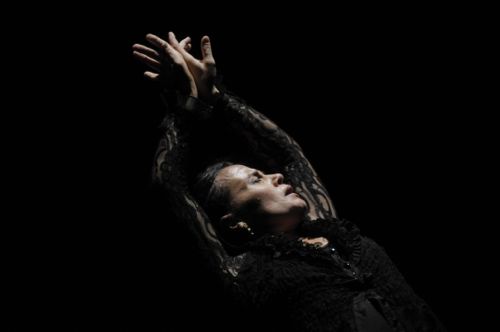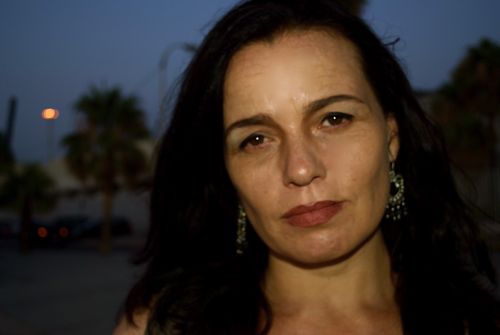Soledad Barrio, one of the greatest dancers of our time, in any genre—hers is flamenco—is giving class. The venue is a modest studio over a ground-floor church on West 86th Street. The dancing arena must boast a very resilient floor in addition to its three chandeliers, the only hint of “décor” in sight.
 Soledad Barrio, onstage
Soledad Barrio, onstage
Instead of one of the long, gaudy ruffled gowns Barrio wears for her existence onstage—which has ignited the imagination of admirers worldwide—she wears a black t-shirt and black trousers flared at the ankles. Her hips are swaddled in a white scarf strewn with bold black ovals that conjure up the notion of paw-prints. Her feet are shod in the classic gear of women practicing her trade—black round-toe pumps with sturdy Cuban heels that have an alternative identity as weapons, now striking or slashing at the floor or delivering urgent whispered messages to it. Her dark hair is yanked back in a braid that becomes more and more wispy as the lesson proceeds. She wears no makeup, not a speck.
Tirelessly, she demonstrates, full-out, over and over again, what she wants from her eight pupils—a motley crew of varying degrees of experience. The quality they have most clearly in common is an unspoken yet evident belief—you can see it in their worshipful gaze—that her knowledge of flamenco is unsurpassed.
Although she may laugh and joke occasionally with her students, she’s subtly merciless when it comes to clarity and correctness. She believes, passionately, that exactitude is essential; clearly she’s a model of that herself. I’d never realized how important it was in her theatrical performances.
When she demonstrates the phrases she’s asking her pupils to reproduce, she seems to be dancing full out, but if you’ve seen her onstage you know that here she’s just marking. In performance Barrio invariably goes far beyond what one pre-conceived as the limit.
Her English is good enough to convey the basics, and, teaching in New York, she naturally uses the local lingo. Needless to say, however, there are enchanting linguistic gaps. To be sure, her regular students understand her better than I could because she’s familiar to them. Like many a dance teacher, she’s a very funny mimic, but her physical imitations of her students’ flawed execution are inevitably far from kind. Not one of the women looks like even a possible Barrio protégée. Why, I wonder, does Barrio lack the caliber of students she deserves?
I adored the few minutes in which she demonstrated “spotting”—the same sort of “trick” ballet dancers use to avert dizziness when executing multiple pirouettes and the cousins thereof. It was enough to make a small child believe the lady was a witch.
I was thrilled by the sight and sound of her the feet hitting the floor faster and faster, a bedazzling form of percussion.
As the pupils are executing a complicated sequence, she says mildly—perhaps a little ironically—“Feel the floor.” Explaining a move that swirls back on itself, she proposes this: “In the last moment, to say yes, you say no.” This is the only instruction she gives in this session that is not solely technical.
Her demonstrations of many a long chain of movements often make you think of eating—of devouring, actually. At other moments she holds her head, jutting into space, like that of a lethal snake injecting its poison into a victim. But she never refers to “meaning” in her instructions, only to movement—the element, as Martha Graham so often reminded us, that never lies.
She stretches an arm out to the side and undulates it, as if whipping up a generous bowl of cream or egg whites, first to a froth, then to firm mountain peaks. Still, there’s no addition of drama.
On a 12-count phrase, she tries to get her students to do nothing on one of the counts. Doing nothing proves to be difficult, a challenge. This is a common problem among dancers, especially the younger ones, no matter what their genre. Only mature, gifted, or “born” dancers have stillness in full command.
 Barrio, offstage
Barrio, offstage
Photo: Gabriela Goldin Garcia
In a class that lasts a good deal longer than the 90 minutes scheduled for it, Barrio never once mentions, or even refers to obliquely, the emotional, psychological, or theatrical aspects of her work—the areas that make her world-famous. I suspect she chooses not to. Perhaps she feels that these elements belong to her alone. Perhaps she’s willing to share her technique but not her artistry, which, for all I know, she considers her identity. Most likely, she’s learned, no doubt the hard way, that some things cannot be taught.
Barrio will be appearing in New York with her company, Noche Flamenca, at Joe’s Pub, January 3-8 (two shows daily except on closing night).
© 2013 Tobi Tobias




Thank you.
Tobi, what an extraordinary experience–to watch a class led by a first-rate teacher/dancer. “Feel the floor” is the key to all dances. Thank you for sharing.
You make me want to get on the next plane to New York, although Barrio (and Noche Flamenco) performed here in Portland last season, putting me and many other audience members on the edge of our chairs, making me forget how much I dislike watching this soul-stirring art form performed on the proscenium stage. My only caveat was that Barrio wasn’t on stage enough; her dancing is addictive. Thanks, TT.
This is a very sweet way to start the new year. I love to watch class, and you’ve let me see one here I otherwise would have missed!
Soledad is the reason I fell in love with flamenco. Noche Flamenca was the first live performance I ever saw, and I was so emotional watching Soledad I was literally brought to tears!
That’s when I knew that I had to be a part of this thing called flamenco and started taking classes!
My dream would be to take a week of classes with Soledad!!!
As one of Sole’s students, one of the “motley” crew as you describe us, I know firsthand what transpires in her studio, and I know how little of it you have captured here. You would need far more than the 90 minutes you spent there to see it, and you would have to be a student yourself to “get” it. Of the many things you missed is the thoughtful analysis Soledad makes of each of her students, regardless of their ability or experience, and the generous effort she puts forth to find just the right correction for each student’s deficits. She is just as generous with her descriptions and analogies for where the movements and feelings come from, and the techniques behind each one. While I agree that most often true artistry can’t be taught, I’ve never felt that Sole “chooses” not to share; quite the contrary, she is perhaps the most generous of all the teachers I’ve worked with.
What kind of student does such a master “deserve”? Only a protegee of her own caliber? I fear that if that were the only criterion, Soledad would wait the rest of her life to find a worthy student. Fortunately, she seems to have a broader definition of worth than the one you imply. I assume she values students of all stripes and abilities who leave their egos at the door and make themselves vulnerable everyday in class out of the love of the art; students who respect and admire, not worship, her mastery of a complex art form and who willingly embark on a life-long learning process with her; students who sweat and work and improve, little by little, and who celebrate that improvement together with her; students who spread the passion for flamenco to everyone they know, and who one day may inspire the next protegee.
Thanks, Glenna, for bringing up the question of the value of art for and by people below the pinnacle of performers. It’s one I’ve been chewing on lately. We have amazing access to the best the world can offer and I think it’s skewed our values a bit. While I don’t much care for amateur or student acting and dancing, I have no problem with the same levels in poetry, painting or singing. I cringe when people complain about less than perfect singing. It’s so natural to sing, even if badly. While one part of my brain asks why offer beginning ballet in college when there’s no hope of becoming a professional when starting so late, another part reminds me of the powerful experience it was for me, changing me at practically a cellular level. I can only imagine her successors are slogging through some hell along with the successors to Graham, Balanchine, Ashton, etc. How lucky we are to have had these people!
Thanks, Tobi, for the line about truth and the meaning of movement. I realized that when I watch European dance, which is so often fraught with meaning, on a subliminal level I don’t trust it because I’m suspicious of its motives and intentions.
Rachel Penner @energyofdance on Twitter:
Beautifully written, evocative piece about flamenco dancer Soledad Barrio. bit.ly/XygLho @TobiTobiasNYC